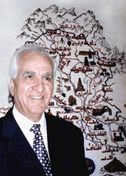Tourist infrastructure
Different civilizations throughout history built monuments that stood for thousands of years, such as fortresses, minarets, churches, mosques etc, in accordance with their beliefs and conceptions of themselves and the world. These edifices also celebrated their achievements and victories.
Tourism, in its present civil conception, was not among the reasons for the construction of these ancestral monuments. Indeed, tourism is a new concept. I can say with confidence that the Eiffel Tower, which is considered a symbol of France, was not built with tourism in mind. It may have been put there for other considerations, such as astronomy, radio transmission or for aesthetic reasons aiming to improve the look of Paris and make it more attractive.
Thus, all monuments that have been constructed before the Second World War had nothing to do with tourism. That means that the goal was not to attract international tourists, but rather national or other ambitions. If the Europeans had decorated their cities with civil monuments to attract tourists, the Second World War should not have exploded and destroyed numerous cities and their inhabitants, not to mention tourism.
After the Second World War, once European states emerged from their isolation, the movement towards travel began and with it the concept of tourism emerged and developed into a reality, which had a significant impact on the economy and science. Consequently, the tourist establishments, as well as countries and even peoples, began to feel the vitality of their new civil and economic beginnings. They started to be interested in the traditional sites, monuments and churches bequeathed to them by previous generations. They propagated a culture of tourism for the locals and foreign visitors.
When I began my business visits to Europe, in the mid 50s I embarked on a spontaneous tourist expedition to visit the cities, churches, and historic monuments: I visited several churches such as the Vatican, and the Dome of Milan. On the terraces, I discovered gigantic statues as well as the panorama of the cities.
I also visited Saint Paul’s in London, the Dome of Cologne in Germany as well as other churches and cemeteries such as the underground cemetery of Rome and the Normandy cemetery, where the soldiers who participated in the liberation of France have been buried. Europe exploited each of these monuments for the benefit of the tourist industry, without taking into account their origins; even the industrial yards and royal palaces were opened to attract visitors.
Europe did not limit itself to its tourist monuments. It began to prepare studies and plans for gigantic projects in order to attract national and foreign visitors. I cannot mention them all so I will limit myself to the project of the London Council which created "The London Eye". This Eye is a big wheel with glass rooms allowing the tourist to have an aerial view of London. This tourist monument is next to restaurants and aquariums where you can see varieties of extraordinary fish of all colours, in addition to photo exhibitions in a limited space next to the former London Town Hall overlooking the Thames. This Eye may attract no less than one hundred thousand visitors a day, according to my estimate. You have to pay to get on to the Eye and it is not cheap. And the council has a nice, regular source of income from this area.
This is the situation in the west. After the Second World War the most important boost to tourism in Europe came from the unification that has enlarged it and given it a unified currency. What are the foundations of tourism in the Muslim world and what are its foundations within our civil, religious and heritage traditions?
If we take a quick look at the way in which most of our cities grow with their important landmarks, we will find that they gained prominence because they have the remains of holy persons of the Prophet’s family or his companions or saints, who attract visitors from all corners of the earth to benefit from their blessings. The sultans and rich leaders spent enormous amounts of money to construct and to restore the mausoleums, and their mosques as well as other services such as medersas (religious schools), in accordance with their belief in the descendants of the prophet, his companions and the saints of Islam. We can mention Najaf, Karbala, Kadimiah, Sayda Zineb (in Damascus and in Cairo) as well as other holy places in other cities. This movement of visitors that we call “Religious Tourism” is constantly increasing.
Thus, the Kingdom of Saudi Arabia extended the places adjoining Mecca and the Prophet's Mosque. It also paid great attention to the requirements of the Hajj and Umrah, and it has made facilities available all year round. It focused on this important economic sector and has invested in it heavily. It also has other Islamic treasures that date back to the time of the rise of Islam and they interest all Muslims. These sites include aspects of the life of Prophet Mohammed, his family, as well as his companions. The re-construction of their cemeteries is part of the reconstruction of Islamic heritage and its monotheistic values. And there is an economic return from millions of visitors from all over the world.
In a similar way, Iran began to allocate some investments for religious tourism, showing a great interest in the holy places and other religious sites. A simple visit to the city of Mashad, with the extension of its constructions and the growing influx of visitors, are all irrefutable proof that the investment in these areas has an important impact on the economic level, as well as in the crystallization of noble human values for locals as well as visitors.
What about Iraq? If God saves Iraq from the present chaos and peace prevails, the love and friendship of its people will guarantee Iraq becomes a first-class tourist destination. After the reconstruction of the infrastructure in all its cities and the satisfaction of the elementary needs of its population, the big investments must necessarily move towards the requirements of the tourism revolution and the reconstruction of mausoleums, holy places, the sites of historic monuments, the cities, the means of transportation, the construction of major hotel complexes and restaurants in order to welcome the millions of visitors or tourists from neighbouring countries and from the West. Tourists will flock to Iraq like bees swarm around a honey comb.
Finally, the investment in the reconstruction of religious sites and the creation of an infra structure of religious and family tourism in our countries is very profitable and more beneficial for our present life and that of the beyond, God willing.
If the Arab-Islamic countries lost the political battle, they should win the tourist battle: that is the mother of all battles. This is what I had in mind when I published the magazine "Islamic Tourism" and its website that has become a cultural landmark referred to by all who visit it.
May God guide us to the best of deeds.
|

